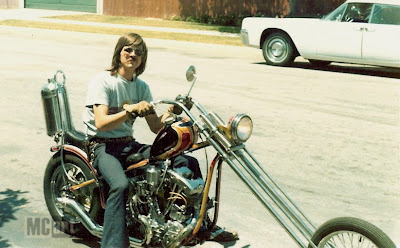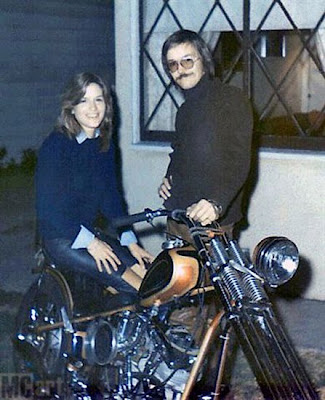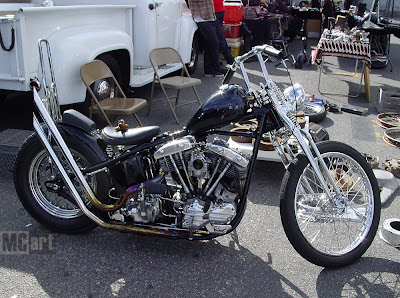 |
| Total sales for MidAmerica over 2.5 days was $5.5Million, inclusive. |
The
MidAmerica 2011 Las Vegas auction held to their 20 year tradition with 500 motorcycles for sale over two and a half days, beginning with a Thursday night after-dinner auction of 50 bikes. The colors, the buzz of the auctioneers, and the scale of the hall should be experienced by every motorcycle enthusiast at some point - once you're in Las Vegas, its a free show of very interesting machinery, much of it unlikely to be seen publicly again for some time. It is also probably the best place in the US to meet bike collectors from around the world, old or young, established or just beginning, very rich or simply looking for one special machine.
 |
| Fritz Simmerlein of www.Harleysons.de is perfectly matched to this original-paint 1919 H-D 'J' |
With 500 bikes on show, in some years a repetitive horde of Triumphs or Shovelhead choppers have made for a tedious auction, but this year the mix was uniformly varied, and had something for everyone. Unrestored 'teens and 'twenties machines, newly-built replicas of Board Track racers, seventies café racers, recent customs, racing bikes, and mopeds were all available.
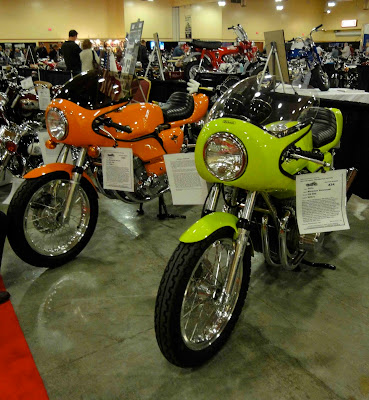 |
| Spring arrived early in Vegas; two Rickman-framed café racers... |
Highlights of the auction included two
Brough Superior SS100s with 'MX' Matchless overhead valve 990cc engines; a 1939 model to 'show finish' (chromed mudguards and cylinders/heads), which had correct, matching engine, frame, and gearbox numbers, and a 1938 example with MX engine, previously owned by Brough technical guru
Bill Gibbard, author of 'Maintaining your Brough Superior'. The Gibbard machine had an engine from another SS100, although the machine was all-Brough. Still, when the reserve is a reputed $230,000, one can afford to be picky, and thus it proved to be when the machine failed to sell at auction (although it sold later in the day for $238k). The '39 'show' bike sold for $260,000+ to a new player in the motorcycle collecting world; more on that later.
 |
| 1939 Brough Superior SS100 'MX' to 'show' specification |
Other interesting machines included a pair of 1934 Dirt Track racers which fetched big bucks due to their rarity and solid-gold provenance. The '34 Harley 'CAC' racer was one of a dozen machines built to challenge the JAP and Rudge racers which ruled the tracks of the time, but as it was no more powerful than the British machines, the model was dropped. This original paint, two-owner bike was a time-warp machine, and fetched well over $120,000.
The 1934
Crocker speedway racer was one of 31 built in the small workshop of Al Crocker and
Paul Bigsby (inventor of the
'whammy bar'), before they focused on their familiar big twins. The Crocker twins reside on Olympus in terms of pricing nowadays, and that glory has reflected well on the rarer dirt racers - this took over $160,000 on the hammer. While not an original-paint bike, the engine and frame were certainly correct, although that extremely rare Crocker carburetor looked brand new to my eyes; a very clean design with 'monobloc' float chamber, such a carb is beyond rare. Both of these '34 racers compare well with the
1929 'Mine Find' Harley Peashooter at Bonhams, which sold for $125,800.
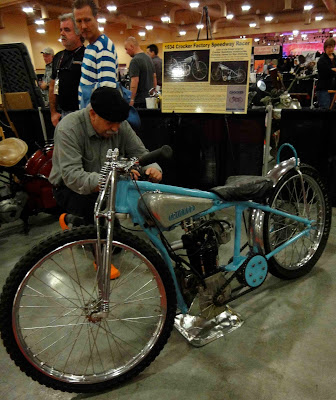 |
| One of 12 Crocker speedway racers known. That's Jeff Decker in the stripes. |
In the replica category was the Flying Merkel from the workshop of ace restorer Chris Carter. Created around an original engine, such shiny machines are fetching less money nowadays than 'patinated' re-creations, a situation which is wreaking havoc with the collector's market. Ron Christensen of MidAmerica noted,
"All these replicas are really scaring buyers away from early American bikes. We had an [unnamed] four-cylinder which turned out to have a replica frame, purchased from France. Sometimes owners have been misled, but we have to be more diligent about documenting the bikes to make clear what we are selling. It's difficult to get paperwork out of sellers, even things as simple as titles!" 
As the skill of 'antiquing' artisans develops, it can be a hard job indeed to tell the difference between a weathered original paint job or a brand new one which simply appears old. Layers of different paint are forcibly 'alligatored' and rubbed with waxes and oils, sepia powders and pumice abrasions to get that just-abandoned look. The ultimate effect of the replicas market has been to make all investors in old American motorcycles especially wary of both restored and original-paint machines. The cry of 'fakery' is heard more often at motorcycle auctions, even against bikes possessing letters of authentication dating decades back! Such wariness is understandable given the number of replicas with a mumbling description in auction catalogs, and it seems high time sellers and auction houses cleaned up their act. Otherwise, its the lawyers who win...and I heard of several big-dollar lawsuits currently pending against well-known dealers and personalities. Perhaps the time has come for a paint-and-metal testing service for valuable machines? The car world takes the lead on this one, although the fine-art world has used paid appraisers/evaluators for a century...

Las Vegas is also the place to see unique machines which never turn up anywhere else, like this 1920s 'Engel' flat twin, which uses a car engine from a Holsman, and home-made frame, forks, and driveline. The wheels are wooden, from a car, and the drive is direct - no clutch or kickstarter. I would estimate the engine capacity at 2liters, which means this heavy beast would be a joy to push-start. It may never have been ridden at all, but has a fantastic look, a 20s 'Dream Machine' (or nightmare!).
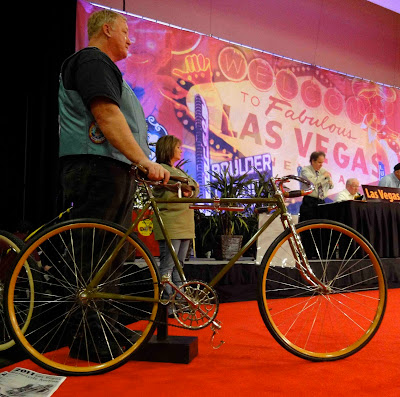 |
| Fantastic H-D racing bicycle ca.1920; the ultimate 'fixie'? |
Prices on the whole at MidAmerica and the Bonhams auction held on Thursday were solid, although they set few records (except a
BSA Rocket Gold Star which fetched $32,760 - surely an American record). The very best machines, such as Brough SS100s, rare racers, and documented original-paint machines, have firm pricing in six-figure territory, although dubious rumors can drop prices considerably. The average rider can breathe easy that high-production machines are very affordable and prices remain flat, if not downright cheap, for Triumph, BSA, and Norton twins, most prewar British bikes, and the average Indian and Harley of all years.
 |
| Fantastic original-paint 1911 Indian belt-drive single. |
The most intriguing new developments in the motorcycle auction world are twofold; the long-anticipated entry of well-heeled automobile collectors into the top tier of the old bike market, and the sudden appearance of bidders from previously silent countries. This year marked what was hoped for/feared/expected for some time, as at least four big-time 'car guys' snatched some of the finest bikes on offer. Their collecting senses already honed by years of dealing with Ferraris and Bugattis, I watched and spoke with several new players leaving the confines of metal bodywork, who sought advice from experienced 'bike guys' regarding the best motorcycles at each auction. The buzz at Bonhams and MidAmerica was less about bikes and prices than flying rumors about who these new players might be, and what this means to the motorcycle world. Regarding the former - the names are well-known to the Pebble Beach crowd, but the latter question hangs for now. When one new player recognized another major car collector was bidding on the same SS100, he deferred, and bidding stopped. Polite for now, such graciousness may evaporate when the current 'toe in the water' becomes a full-fledged desire to amass a serious motorcycle collection complementing their four-wheeled treasures....and when that happens, records will be broken.
 |
| The 'second' Brough SS100; not often you see a B-S on the showroom floor, with a price tag! It later sold for $238,000. |
The second notable trend of the week was the appearance of collectors from 'new' countries buying bikes to bring home. South America and India have for decades been the happy hunting ground for collectors brave enough to travel or send money to unknown individuals with interesting machines...and I count myself among them, having sourced several Brough Superiors from South America in the early 1990s. It seems they want some of these bikes back! In the 1980s and 90s, it was assumed that bikes sold
en masse to Japan or Europe would 'never be seen again', but in truth motorcycles, as when new, circulate around the world to enthusiasts, coming and going as interest and economies wax and wane. It will be interesting to see if the rapidly developing economy of India will produce a new wave of collectors, as Indians are currently buying 300,000 new bikes
per month. They have a long tradition of appreciating older machines, although we have yet to see top-notch restorations emerge from their still-large home supply of prewar English machines...which is probably why they're buying good bikes here.
 |
| The vast hall of the South Point Casino. |
 |
| 1960 H-D Panhead custom, 'Acid Trip'. Indeed. |
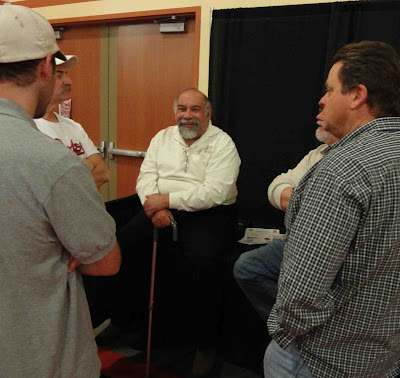 |
| Cabal of early American bike collectors, setting prices and determining the future of the market. Or not. |
 |
| Goggomobile! And a Berkeley; almost motorcycles... |
 |
| The H-D sprocket of the racing bicycle. |
 |
| 1935 HRD Series 'A' Comet |
 |
| 1910 Marsh Metz belt-drive single |
 |
| The clutch and belt tensioner levers of the Marsh Metz; two ways to slow down or start up. |
 |
| Stunning if creepy H-D 'dresser' with Marylin undressed everywhere. |
 |
| Plenty of rare European machines on offer, such as this 1905 Motosacoche, without the typical engine cladding. |
 |
| Bad year for Munchs in America; none have sold here since the Dave Manthey collection was dispersed. |
 |
| 1936 BMW R5, the rigid version of the R51, and very desireable. |
 |
| Tremendous variety; Vespa to genuine '75 Norton JPS Commando to dirt bikes. |
 |
| 1938 Husqvarna moped - fun! |











